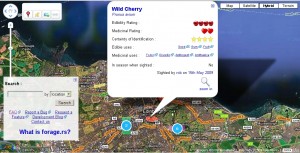- Making mesquite pancakes.
- The origin of hummus.
- “But militants on the one side and security forces on the other shot dead these dogs as they set off alarms at every movement. Now we are hardly left with any dogs.”
- “Sand food” is endangered, apparently.
Nibbles: WFP and Millennium Villages, Agroecotourism squared, Mango, Wild pollinators, CGIAR change process, Grape breeding, Landraces and climate change, Mau Forest, Eels
- “…WFP’s partnership with the Millennium Villages Project would deploy the full range of the Programme’s tools and help utilize the Millennium Villages as a platform for best practices.” Good. But let’s just hope the villagers’ own best tool — agrobiodiversity — doesn’t get left behind.
- More on the Cotacachi agroecotourism project in Ecuador.
- Heritage tourism in the Virgin Islands targets old sugar cane mill.
- The “mango villages” of India.
- Pollination needs to go wild.
- Ok, so the CGIAR is going to re-organize itself into mega-programmes (look at the PDF at the bottom of the page), one of which is on “Crop germplasm conservation, enhancement and use.” Big deal? I wish I knew.
- Pssst, wanna discuss grape breeding?
- More from IIED on landraces and climate change.
- Deforestation, drought and politics in Kenya.
- Tracking eel migrations.
Of collapse and restoration
There’s a new paper by Jared Diamond out, always a welcome event. Alas, it is behind a paywall at Nature, but it is fairly easily summarized. Drawing on recent studies of the collapse of Classic Mayan civilization in Central America and Angkor in Cambodia, and the rise of the Inka empire in the Andes, it makes two main points. One, that civilizations may collapse for multifarious reasons, but “human overexploitation of natural resources never helps.” Two, that “climate can change in either direction.” Not particularly novel or surprising conclusions, but Diamond does his usual slick job of marshaling disparate, multidisciplinary evidence from tourism hotspots all over the world and from throughout history to advance arguments of great contemporary relevance, slight whiff of environmental determinism notwithstanding.
In this case, what struck me particularly was the success story. That is, how climatic change after AD 1100, during the Northern Hemisphere’s Medieval Warm Period, may have helped the Inka’s conquests. The argument is that higher temperatures allowed them to extend agriculture to higher altitudes, increase their arable-land area and make more use of irrigation, leading to greater production and the possibility of feeding large armies. Of course, “military and administrative organization was essential to their conquests, [but] climate amelioration played a part.”
The evidence for agricultural expansion comes from the work of Alex Chepstow-Lusty and colleagues, who analyzed the pollen and other plant parts (and, indeed, other organisms) in mud cores from a high-altitude Andean lake bed. Some of the plant parts came from an alder-like tree. I had no idea that the Inka planted the nitrogen-fixing Alnus acuminata. Its remains increase in lake sediments dated from about AD 1100, along with ambient temperatures and the bodies of llama dung-eating mites, showing that there was starting to be more agriculture and livestock-keeping around the lake at that time.
The success story came to an end, of course. The Spanish cut most of alders down for fuel. Chepstow-Lusty is calling for “massive reintroduction of native tree varieties, such as the alder, to trap moisture blowing over from the Peruvian Amazon to the east. He also recommends repair of the now derelict Incan canals and terraces so they can once again support agriculture.” Have there been similar suggestions for the restoration of the agricultural infrastructure — physical and biological — of the Maya and Khmer? Maybe all the tourists could be put to work on this — or at least tapped for cash.
Nibbles: Moufflon, Eartworms, Charcoal
- Hunting wild sheep relatives in Armenia.
- Counting earthworms in Scotland.
- Making charcoal in Africa. Money stat: Rural electrification rate in sub-Saharan Africa is 8%.
Mapping free fruit
Free-fruit enthusiasts have put together a Google Maps application to help them forage. Only has a few sites around Britain and Germany at the moment, but I bet it will grow.
Would it be so difficult to have something similar to report threats of genetic erosion, for example? I know Jacob thinks that would be useless, as a threat is only really a threat if it is likely to have an effect on overall genetic diversity, not just on what is available locally. But I’m not so sure. And it would be fun to do.
